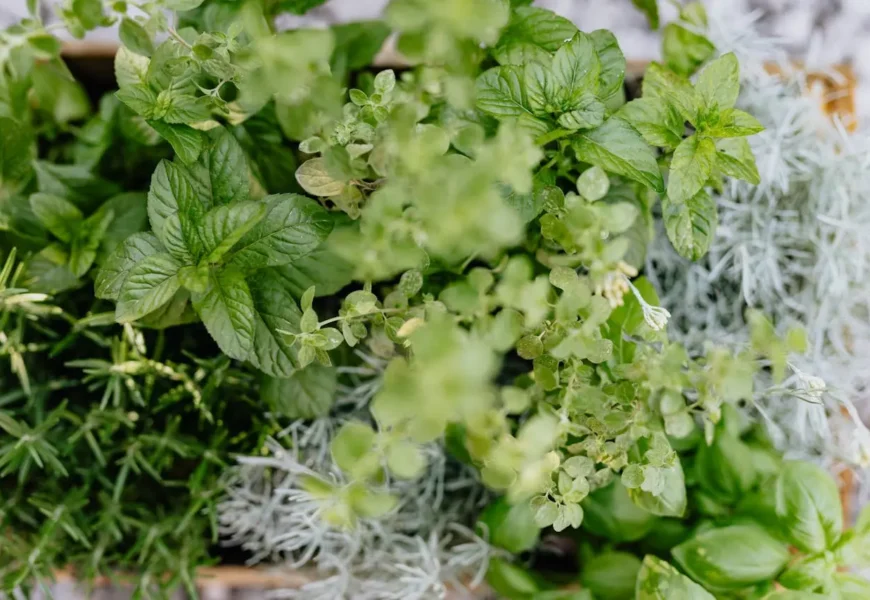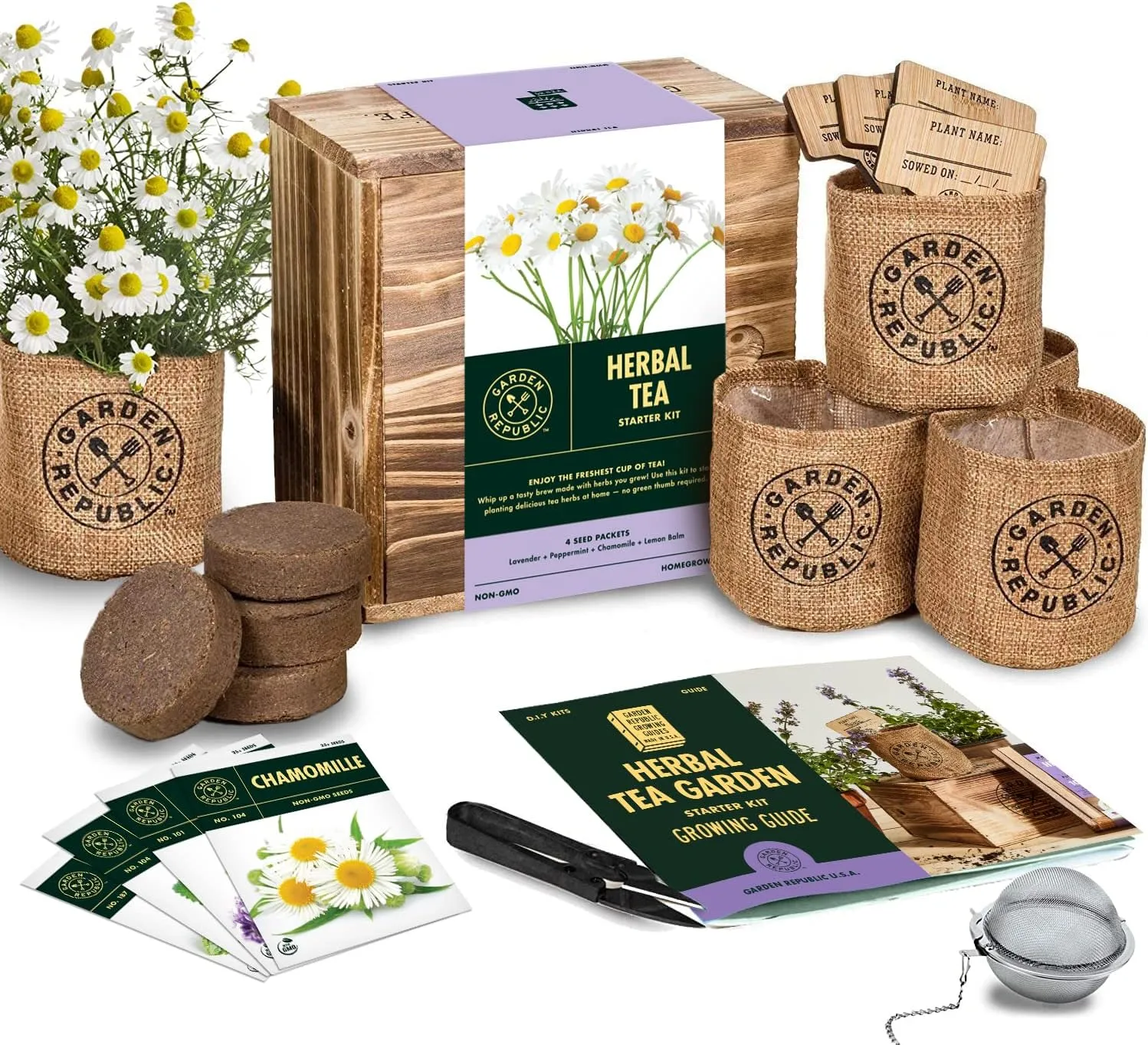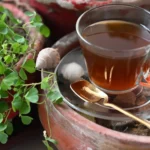Imagine sipping a steaming cup of tea, its aroma filling your senses, knowing you’ve cultivated the very herbs that brought it to life. That’s what happens when you grow your own tea at home! It’s a journey that starts with you with a single seed and blossoms into a flavorful, aromatic experience.
This comprehensive guide will guide you through the process of creating your very own tea garden, from choosing the right herbs to savoring the final brew. Whether you’re a seasoned green thumb or a curious newcomer, this guide will help you embark on this rewarding endeavor. Let’s dive in!
Table of Contents
- Choosing the Right Herbs: Unveiling the world of tea, exploring various types, their growing conditions, and perfect picks for beginners.
- Sowing and Planting: Mastering the art of starting seeds indoors or directly in the garden, selecting the ideal location, and perfecting planting techniques.
- Caring for Your Herbal Garden: Unveiling the secrets to keeping your tea garden thriving, including watering, feeding, weeding, and pest control.
- Harvesting and Drying Your Herbs: Unlocking the secrets to harvesting for maximum flavor and potency, and exploring various drying methods to preserve your herbal treasures.
- Brewing Your Homegrown Tea: Mastering the art of brewing, uncovering tips for delicious infusions, and exploring exciting flavor combinations.
1. Choosing the Right Herbs To Grow Your Own Tea
Are you ready to embark on the exciting journey of growing your own tea? Before you grab your trowel and start digging, let’s first explore the fascinating world of tea plants.
There’s a common misconception that tea is solely derived from Camellia sinensis, the source of black, green, white, and oolong teas. While it’s true that Camellia sinensis is the star player, a whole universe of herbs awaits, each offering its unique flavor profile and health benefits.
For the home gardener, exploring the vast world of herbal teas can be both exciting and overwhelming. It’s important to start with herbs that are relatively easy to grow and suit your local climate.
What to Grow in a Tea Garden:
- Mint: A quintessential tea garden staple, mint is known for its refreshing, cooling properties and adaptability. It’s easy to grow and spreads readily.
- Chamomile: This gentle herb boasts calming properties and a sweet, floral flavor. It thrives in sunny locations.
- Lemon Balm: A delightful herb with a lemony tang, it’s prized for its uplifting aroma and digestive benefits.
- Lavender: Lavender’s calming scent and beautiful blooms make it a cherished addition to any garden. It prefers well-drained soil and ample sunlight.
- Rooibos: This South African herb is naturally sweet and caffeine-free, making it a perfect choice for those seeking a gentle, soothing beverage. Rooibos is a bit more challenging to grow indoors, but it can be done with some careful planning and attention to its needs.
Pro Tip: If you’re a beginner, consider starting with an indoor tea garden kit. These kits provide everything you need to get started, including seeds, pots, and growing medium.
Thinking About Growing Camellia Sinensis Indoors?
While not impossible, growing Camellia sinensis indoors is a bit more challenging. It’s a subtropical plant that requires consistent warmth, high humidity, and ample sunlight.
Here are some factors to consider if you’re interested in growing Camellia sinensis indoors:
- Sunlight: Camellia sinensis thrives in bright, indirect sunlight. It’s essential to provide at least 6 hours of sunlight per day.
- Temperature: Camellia sinensis prefers temperatures between 65-75 degrees Fahrenheit.
- Humidity: Camellia sinensis needs high humidity. You’ll need to use a humidifier or other methods to create a humid environment.
- Soil: Camellia sinensis requires well-drained, acidic soil.
Remember, patience and consistent care are key to success when growing Camellia sinensis indoors.
In the next section, we’ll delve into the art of sowing and planting your tea garden, covering everything you need to know to get your herbs off to a thriving start.
2. Sowing and Planting: Starting Your Indoor Tea Garden Adventure
You’ve chosen your tea heroes – a vibrant mix of herbs and maybe even a brave Camellia sinensis (the true tea plant). Now it’s time to get those tiny seeds or seedlings ready to flourish in your very own indoor tea garden. Let’s dive into the exciting world of starting your tea garden indoors!
Starting Seeds Indoors:
- Get Cozy with Seed Trays: Seed trays are your best friend for starting seeds indoors. Fill them with seed starting mix, a lightweight blend specifically designed for tender sprouts.
- Sowing Time: Carefully sow the seeds according to the instructions on the seed packet. Most tea plants appreciate a gentle press into the soil, but avoid burying them too deep.
- Warmth and Light: Tea plants need warmth and light to germinate. A sunny windowsill or a heated seed mat will work wonders.
- Moist, but Not Soggy: Keep the seed starting mix consistently moist, but avoid overwatering. You want the soil to be damp, not drenched.
- Thinning: As your seedlings emerge, thin them out if they’re crowded. This gives each little plant space to grow strong and healthy.
Direct Planting:
- Choosing the Right Pot: Select pots with drainage holes to prevent soggy roots. Tea plants prefer pots that are slightly larger than their root ball, allowing room for growth.
- Potting Mix Perfection: Use a well-draining potting mix specifically formulated for indoor plants. This provides the essential nutrients and texture your tea plants need.
- Gentle Handling: Carefully remove the seedling from its nursery pot or seed tray, trying to avoid disturbing the delicate root system.
- Planting Depth: Plant your tea seedlings at the same depth they were growing in the seed tray or nursery pot.
- Firmly Settled: Gently firm the soil around the seedling’s roots. This helps them establish a strong foundation.
Location, Location, Location:
- Sunlight’s Embrace: Tea plants crave bright, indirect sunlight. A sunny windowsill with a few hours of direct morning or evening sun is ideal. Avoid direct midday sun, which can scorch delicate leaves.
- Temperature Matters: Most tea plants thrive in temperatures between 65°F and 75°F (18°C to 24°C). A consistently warm spot near a window is perfect.
Remember, this is just the beginning! Once you’ve successfully started your seeds or seedlings, it’s time to move on to caring for your growing tea garden. We’ll delve into the world of watering, feeding, and keeping those pesky pests at bay in the next section!
3. Caring for Your Herbal Garden: Essential care tips, including watering, fertilizing, weeding, and pest control.
Once your tea garden is planted, it’s time to give it the TLC it needs to thrive. A little bit of effort goes a long way in ensuring healthy and flavorful herbs. Here’s what you need to know about caring for your indoor tea garden:
Watering:
- The Goldilocks Rule: Just like us, your plants need the right amount of water – not too much, not too little. Overwatering can lead to root rot, while underwatering can stunt growth.
- Feel the Soil: The best way to determine if your plants need a drink is to check the soil moisture. Stick your finger about an inch deep into the soil. If it feels dry, it’s time to water.
- Drainage is Key: Make sure your pots have drainage holes to prevent water from pooling at the bottom, which can suffocate the roots.
Fertilizing:
- Nourishing Your Plants: Your tea garden needs a regular dose of nutrients to grow strong and healthy. You can use a balanced liquid fertilizer diluted according to the manufacturer’s instructions.
- Organic Options: Look for organic fertilizers made from compost or fish emulsion to avoid introducing harsh chemicals to your plants.
- Observe Your Plants: Pay attention to any signs of nutrient deficiency, such as yellowing leaves or stunted growth. If you notice these issues, adjust your fertilizing schedule or try a different fertilizer.
Weeding:
- Keep it Clean: Weeds compete with your tea plants for nutrients and water. Regularly remove weeds by hand to give your herbs the best chance to grow.
- Mulch Makes a Difference: A layer of mulch around your plants helps to suppress weeds and retain moisture.
Pest Control:
- Early Detection: Keep a watchful eye on your plants for any signs of pests, such as insects, mites, or aphids.
- Natural Solutions: Start with natural pest control methods like insecticidal soap or neem oil. These are less harmful to your plants and beneficial insects.
- Avoid Pesticides: Chemical pesticides can be harmful to your plants and the environment. Try to avoid them if possible.
Additional Tips for a Happy Tea Garden:
- Sunlight is Key: Most tea plants need at least 6 hours of direct sunlight each day. If you don’t have enough sunlight, you can use grow lights to supplement.
- Air Circulation: Good air circulation helps to prevent fungal diseases and keeps pests at bay.
- Patience is a Virtue: Growing tea takes time. Don’t expect to have a bountiful harvest right away. Be patient, and enjoy the process of nurturing your own tea garden.
4. Harvesting and Drying Your Herbs: Bringing Your Own Tea Garden to Life
Now that your tea garden is flourishing, it’s time to reap the rewards of your hard work! Harvesting your herbs at the right time is crucial for maximizing their flavor and potency. This section will guide you through the process, making sure you get the most out of your homegrown tea.
Knowing When to Harvest
The best time to harvest your herbs depends on the specific plant and its purpose. Generally, you want to harvest the leaves when they are young and vibrant, as older leaves can become tough and bitter.
For most leafy herbs, like mint, lemon balm, and chamomile, harvest the leaves in the morning after the dew has dried.
For flowering herbs, like lavender and calendula, harvest the flowers when they are fully open but before they start to wilt.
For herbs with stems and leaves, like rosemary and thyme, harvest the stems when they are young and tender.
Harvesting Techniques
Use sharp scissors or pruners to make clean cuts, avoiding tearing the leaves or stems.
Avoid harvesting more than one-third of the plant at a time, to allow it to continue growing.
Harvest leaves before they become too large, as they will be more tender and flavorful.
Drying Your Herbs
Drying your herbs is essential for preserving their flavor and aroma. Here are a few common drying methods:
1. Air Drying:
Hang your herbs in a dry, well-ventilated space, like a cool, dark room or an attic.
Tie the stems together with twine, forming bundles, and hang them upside down.
Make sure the bundles are spaced apart to allow for good airflow.
Drying time varies depending on the herb and the climate, but most herbs will take 1-2 weeks to dry.
2. Microwave Drying:
Lay the herbs in a single layer on a microwave-safe plate, covered with a paper towel.
Microwave on high power for 1-2 minutes, checking every 30 seconds to prevent burning.
Let the herbs cool completely before storing.
3. Dehydrator Drying:
Use a dehydrator, following the manufacturer’s instructions.
Dry the herbs at a low temperature, between 95-115 degrees Fahrenheit.
Drying time will vary depending on the herb and the dehydrator, but most herbs will take 4-8 hours to dry.
Storing Your Dried Herbs
Once your herbs are dry, store them in airtight containers in a cool, dark, and dry place. This will help to preserve their flavor and aroma for several months.
From Harvest to Infusion: The Journey of Homegrown Tea
By following these harvesting and drying techniques, you’ll be able to enjoy the delicious flavors and health benefits of your homegrown herbs all year round. Ready to brew your own herbal tea? Check out our guide on Brewing Your Homegrown Tea for tips on creating flavorful infusions.
Remember, the journey of growing your own tea is as much about the process as the final product. It’s a chance to connect with nature, appreciate the beauty of your garden, and savor the delicious taste of your own creations. Enjoy the journey!
Grow Your Own Herbal Tea: Enjoy a fresh cup of tea, straight from your home garden!
This tea garden kit comes with heirloom, non-GMO Mint / Peppermint, Chamomile, Lemon Balm, and Lavender herb seeds to start your very own herb garden.
5. Brewing Your Homegrown Tea: Basic brewing techniques, tips for creating delicious infusions, and exploring different flavor combinations.
Now that you’ve harvested your fragrant herbs, it’s time to enjoy the fruits (or rather, leaves) of your labor. Brewing tea is a simple yet rewarding process, offering a chance to experiment with different flavor combinations.
Basic Brewing Techniques
- Use fresh, clean water: Start with filtered or spring water for the purest flavor.
- Choose the right temperature: Different herbs have optimal brewing temperatures. For most herbal teas, boiling water is too hot and will scorch the delicate flavors. Use a thermometer to ensure the water is at the recommended temperature.
- Steep for the right amount of time: Over-steeping can lead to bitterness. Refer to the specific herb’s instructions for optimal steeping times.
- Strain before serving: Use a fine-mesh strainer to remove leaves and stems from your tea.
Tips for Delicious Infusions
- Experiment with combinations: Don’t be afraid to mix and match different herbs for unique flavor profiles.
- Add sweeteners or other ingredients: Honey, maple syrup, lemon, or ginger can add complexity to your tea.
- Serve hot or cold: Enjoy your tea hot, iced, or even in a refreshing summer smoothie.
Beyond the Basics: Exploring Flavor Combinations
The world of tea is vast and flavorful. Here are some ideas to get you started:
- Classic Combinations: Try a simple blend of mint and chamomile for a calming and refreshing beverage.
- Citrus Infusion: Add lemon balm, lemon verbena, or orange peel to your tea for a bright and tangy twist.
- Spicy Kick: Incorporate ginger, cinnamon, or cloves for a warming and aromatic experience.
- Floral Delights: Infuse your tea with rose petals, lavender, or hibiscus for a delicate and fragrant taste.
Conclusion: A Cup of Homegrown Happiness
Growing your own tea garden is an enjoyable and rewarding experience, allowing you to connect with nature and enjoy the fruits of your labor. Whether you’re a seasoned tea enthusiast or a curious beginner, embark on this journey and discover the wonderful world of homegrown tea!
Remember, you can find more inspiration on how to create your own indoor tea garden at From Seedling to Steeping: Cultivate Your Own Indoor Tea Garden for Fresh Brews.
Enjoy your tea!








